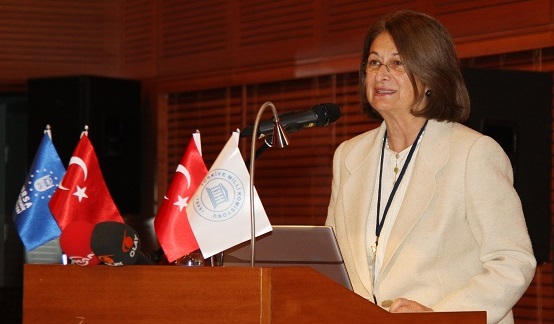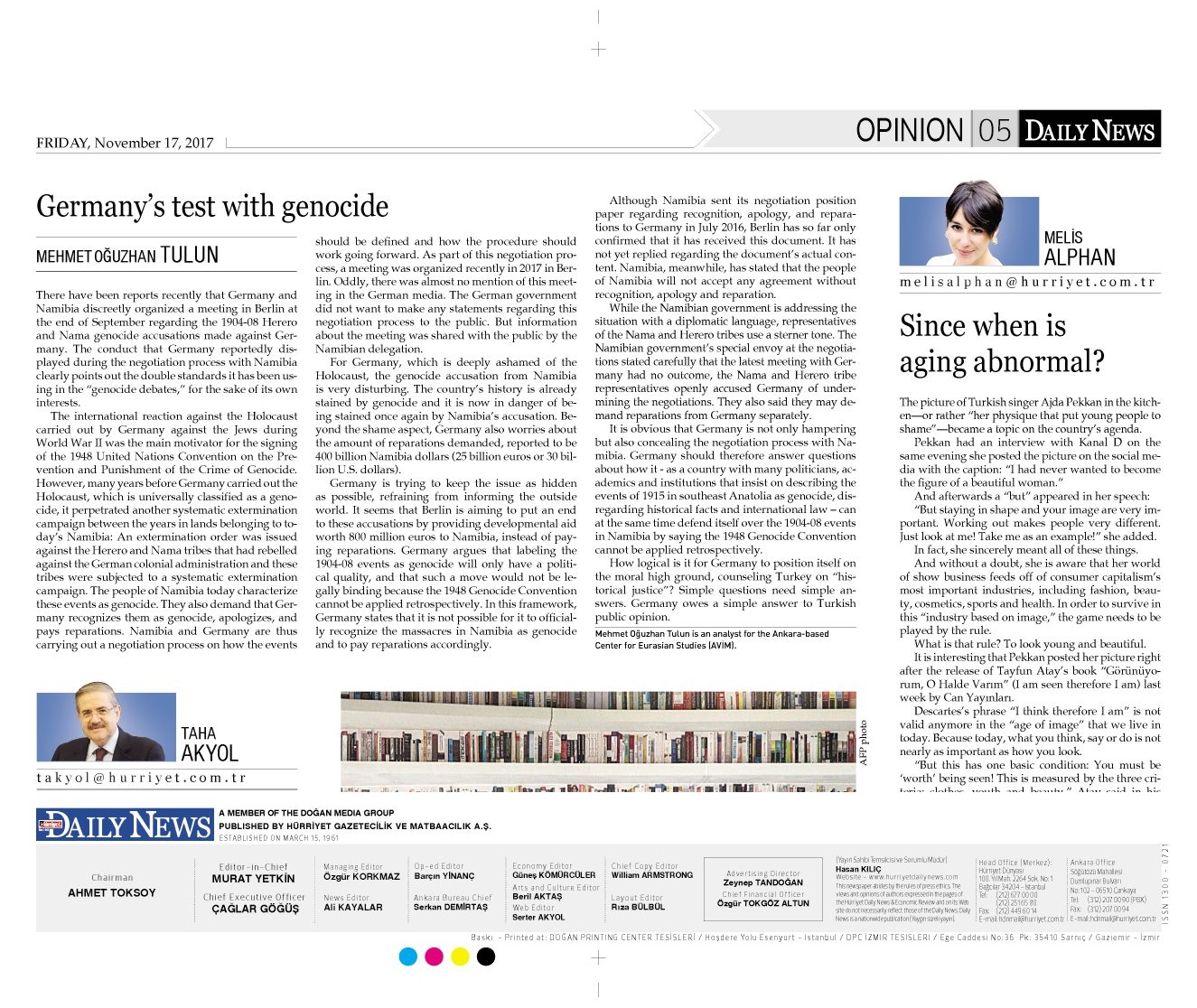Ahmet ERTAY
Ambassador (R)
In November 2013, it will be recalled, the five permanent members of the United Nations Security Council and Germany mutually agreed on a comprehensive ‘Joint Plan of Action’ (JPA) in Geneva which, in broad terms, reciprocally freezes Iran’s nuclear program and new sanctions, and relieves existing sanctions to some extent. The negotiations, started in January 2014 under the JPA did not reach a result despite an extension until July. At the meeting which took place in Vienna in November 2014, the negotiations were further extended until June 30, 2015.
As might be expected, the parties sounded optimistic after the recent decision of extension. US Secretary of State John Kerry said that they have made real and substantial progress especially in the last days of the negotiations, and aim to reach a political agreement within four months. He further stressed that it is possible to not arrive at a workable agreement and that they would not sit at the negotiation table indefinitely unless some measurable progress is reached. British, French and German Foreign Ministers also have made similar statements. President of Iran Rouhani stressed in Tehran that the attitudes of the parties converged during the negotiations.
The last extension prevented the collapse of the negotiations, and kept the hope on a peaceful resolution of the nuclear program of Iran, a source of tension for the last twelve years.
However, the decision to continue the negotiations did not eliminate the risks, as the negotiations seek a resolution for a complex international issue which has political, technical and legal dimensions. On the other hand, the negotiations on the nuclear issue, which is in fact very complicated, is under the pressure of external factors as well.
Efforts by proponents of a tougher stance in the US and Iran to block an agreement
There is a concern that proponents of a tougher stance in the US and Iran would use the extended time to block a possible agreement.
The US government’s job became even more difficult after Republicans gained majority in both houses of the Congress. A strong group of Republicans asserts that any agreement would bring legitimacy to Iran’s nuclear program within the framework of international law, and that Iran, after improving its economy as a result of sanctions relief, would accelerate its clandestine operations while ignoring its commitments. Iran’s access to the nuclear weapon could be prevented, they stress, only by the threat of use of force and harsh sanctions.
With the provocation of Israel, Republicans threaten to pass a bill through Congress imposing new sanctions on Iran. Even though President Obama stated that he would veto such a bill, the Congress has the authority to override President’s veto with a qualified majority. The speaker of the US House of Representatives, who is a Republican, invited Israeli Prime Minister to Washington in March to address both houses of the Congress in order to raise support to the proponents of a tougher stance.
Iranian President Rouhani, who won the elections promising to lift the sanctions and improve the economy, is uncomfortable at home as well. Besides the reluctant support of the religious leader Khamenei, there are attempts by the Revolutionary Guards, who strictly oppose an agreement, to limit the maneuvering space of the negotiation team.
The Influence of the Countries in the Region
The assessment and the attitude of Israel and the Gulf countries, notably Saudi Arabia, are parallel to the proponents of a tougher stance in the US. It is obvious that these countries, which harbour deep mistrust toward Tehran, will stand against any agreement which would not cease Iran to be a threat.
After the last extension decision, Israeli Prime Minister Netanyahu welcomed the failure to reach an agreement, thus evading Iran’s efforts for a settlement. According to the Israeli Prime Minister, it is better to not have an agreement than having a bad one. As for Saudi Arabia, it is publicly known that it encouraged an armed attack on Iran’s nuclear facilities, thanks to the US diplomatic correspondences revealed by Wikileaks.
As John Kerry mentioned, efforts to reach a political agreement, if possible within four months, before the deadline of 30 June 2015, aims to minimize the danger.
Indeed, the German Foreign Minister Frank Walter Steinmeier in his statement following the decision to extend negotiations, stated that the demands of the Middle East countries not represented in the negotiations, made it harder to reach an agreement: ‘We bear responsibility not just for us six but for many states in the world that have legitimate security concerns about Iranian nuclear program’.
The Middle Eastern countries, indeed, are worried that the US would embark on a ‘grand bargain’ and make concessions that would weaken their own security for the sake of reaching a settlement on the nuclear issue. Although the US has guaranteed, in response to these worries, that resolution would be sought within the sole dynamics of the nuclear issue, it would be unrealistic to expect the regional developments not to make an impact on the negotiations.
The effect of the studies conducted separately by the IAEA
Another element that puts pressure on the negotiations is the study the International Atomic Energy Agency (IAEA) is conducting separately in order to eliminate suspicions about possible military aspects of Iran’s past nuclear activities. While it is recognized that Iran generally adheres to the Joint Plan of Action, the same thing cannot be said about the separate study conducted by the IAEA. It is reflected in the IAEA reports that Iran did not show sufficient cooperation on this matter, that it did not allow the inspection of plants and areas, the questioning of some experts. It is hard to finalize the nuclear negotiations unless suspicions regarding this matter are eliminated.
‘The Disaster Scenario’
The breakdown of the negotiations one way or another may increase the possibility of unilateral Israeli military operation against Iran’s nuclear facilities. The conflict may pull the military power of Saudi Arabia and the US in the region into it and prompt Iran to close the Strait of Hormuz to tanker traffic and thereby trigger a global economic crisis. Following a possible - military attack, Iran would be expected to withdraw from the Treaty on the Non-Proliferation of Nuclear Weapons (NPT), deport IAEA inspectors and accelerate its efforts to acquire nuclear weapons. These developments could lead other regional countries to possess nuclear weapons. (Saudi Arabia, Egypt and even Turkey are mentioned in this context by western politicians and the media).
This is ‘the disaster scenario’ the nuclear negotiations try to eliminate.
Another negative result of this disaster scenario is a likely impairment of the collaboration among P5+1 countries in the UN Security Council that has been sustained until today to some extent. In this case, China, which is the major customer of Iran’s oil, and Russia, which made a deal with Iran on building new nuclear plants, should not be expected to vote for additional harsh sanctions on Iran. Iranian officials have already stated that in case of the failure of the negotiations they would use the ‘east card’, which means more collaboration with and more market share to Russia and China. , and pledge more market shares with those two countries. To what measure the Iranian calculus could actualize with regard to Russia, which itself faces western sanctions over the Ukraine crisis, is disputable.
Iran must be expecting a possible failure of the negotiations to create splits within the western block, and some European Union countries, eager to benefit from the Iranian market, to challenge sanctions.
Indeed, it should also be taken into consideration that countries in the western bloc, looking forward to profitable relations with Iran in the event of normalization, could be encouraging the three EU member states and the US to successfully finalize the negotiations. Normalization would open up the big Iranian market to western goods, foreign investment and tourism. Iran would be an alternative to Russia as a supplier of oil and natural gas to Europe, and collaboration in resolving regional problems would be possible. These are economic and politic benefits that cannot be easily ignored.
Negotiating positions of the parties
Iran’s position prior to the Joint Plan of Action, in brief, was to demand acknowledgement of the NPT right to unfettered peaceful use of nuclear technology and the lifting in a single stroke of the sanctions imposed by the UN and separately by the US and the EU.
In the same period, the US (and Israel who tried to influence negotiations behind the scenes), took the attitude of completely stopping Iran’s nuclear activities and lifting embargos gradually over a period of time.
When it was clear that these positions were impossible to materialize, the parties agreed on the JPA that state of affairs and accepted to find a solution outside of these two extremes. With the plan, Iran agreed that certain restrictions could be imposed on its nuclear program and P5+1, on its part, agreed that Iran could maintain a nuclear program within certain restrictions.
Thus, an important threshold was crossed. However, 10 months of negotiations nonetheless could not produce any result. The negotiators’ job isn’t also easy henceforth.
In view of the situation created by the JPA, it is possible to foresee that the US would want to draw the overall framework of a possible agreement as such:
· Enough time for response in case of Iran’s breach of the provisions of the agreement;
· Allocating Iran adequate capacities for practical needs;
· Taking necessary precautions in order to prevent the reversal of restrictions on Iran’s nuclear activities;
· Giving IAEA broad authority for supervision in Iran to prevent the breach of the agreement;
Let’s briefly elaborate on these points.
The top priority of the US, in a possible agreement, is to prolong the time Iran will use to “break-out”. As mentioned in our article published on AVIM’s web site on December 17, 2014, “break-out” time is the time needed by Iran, after taking the relevant political decisions, to produce high-enriched uranium enough to make a nuclear weapon.
The calculation of the “break-out” time varies according to the number and technological capacity of centrifuges Iran uses to enrich uranium. According to the analyses by prominent think tanks in the US, the time needed by Iran, after taking the political decision, to produce adequate quantity of high-enriched uranium using its current capacities is about 2 months. This time is regarded as insufficient by the international community to properly react against Iran. A confident “break-out” time should be one year and therefore, the physical and technologic nuclear capacity reserved for Iran’s use should be determined accordingly. In order to achieve this, a large portion of more than 15.000 centrifuges operational in Iran’s nuclear facilities should be dismantled, and new generation of centrifuges developed by Iran, of which and a 1.000 have been deployed, should be put out of use.
Another Iranian nuclear facility that is of concern for the US is the plutonium production facility in Arak which is almost completed. The separation of plutonium produced here to enable its use in a nuclear device is another technological way to produce a nuclear weapon. In a potential final agreement, it is obvious that the US will insist on the closure of this facility or changing its purpose.
According to the US perspective, this restricted capacity will be enough for Iran to meet its practical needs.
In order to prevent the reversion of restrictions on Iran, the US will obviously want sanctions to ease gradually as Iran fulfills its obligations under a possible agreement. Therefore, the US wants a potential agreement to be implemented over a long period of time, like 20 years, and sanctions to be lifted during such a time frame.
On the other hand, in order to enable control compliance with a potential agreement, giving IAEA broad safeguards authority in Iran is among the issues US will insist on. In this context, Iran will be asked to agree with inspection measures beyond the “Additional Protocol” which Iran has signed with the IAEA but has yet to ratify and implement.
It is not hard to guess that Iran will resist such extensive demands. As a matter of fact, this the main reason why in-depth negotiations for about one year have not produced a positive outcome.
Additional difficulty: the complex structure of US sanctions
Presumably, another hard topic at the negations is how and when the sanctions on Iran will be lifted.
Iran expects all sanctions to be lifted in a single stroke once an agreement is reached. Influential circles in the US, which harbor deep mistrust towards Iran, are forcing the Administration to make a gradual arrangement that links the easing of sanction with the steps Iran will undertake in accordance with the final agreement.
Since a potential agreement with Iran will enjoy the endorsement of all the permanent members of the UN Security Council, changes in sanctions by the UNSC in line with the agreement will not be a problem. This is also the case for European Union embargoes. However, it is not possible to say the same regarding the unilateral sanctions imposed by the US.
Not all aspects of the sanctions regime put in place by the US in accordance with its own legislation is linked with the prevention of Iran’s nuclear activities or with the proliferation of nuclear weapons. In a period of more than thirty years, additionally, a complex structure of sanctions have taken shape based on Iran’s violations of human rights, its support to international terrorism, its democratic deficiencies as well as on general foreign policy priorities of the US.
The authority to temporarily suspend a large part of sanctions rests with the President. Nevertheless, the permanent lifting of an important part of sanctions is subject to the approval of the Congress. Even if the President decides to suspend sanctions by an executive decision, he is required to reassure the Congress about the underlying reasons. It is clear that the processes of lifting and even suspending some sanctions will not proceed easily in a setting where the Republicans hold the majority in both chambers of the Congress.
Russia’s stance
In addition to these difficulties, the US is understandably concerned that Russia, who views Iran’s thaw with the West not perfectly serving its long term interests, while appearing as pro-agreement, is taking steps that can weaken the P5+1’s stance at the negotiations.
Following Russian Defense Minister’s visit to Tehran on January 20, according to press reports, Russia offered Iran to strengthen its air defense systems. Strengthening air defense systems will complicate (even deter) a possible aerial assault, thereby weakening the basis of Obama’s discourse “all options are on the table” he uses to placate proponents of a tougher stance.
This being the case, the US and Iranian delegations have reportedly met in Zurich on January 23-24 to directly exchange views ahead of full negotiations planned for early February.
What could briefly be said for now is that it is likely to miss the March target for a political agreement and to fail to reach an agreement by June 30, the date set for the conclusion of negotiations.
(*) This is a translation made by AVIM from the original text in Turkish which was published on AVIM's website on 2 February 2015.
© 2009-2025 Center for Eurasian Studies (AVİM) All Rights Reserved
Henüz Yorum Yapılmamış.
-
BALKAN KAPİTALİZMİ: ŞÜPHELİ KOŞULLARDA ZENGİN OLMAK
Erhan TÜRBEDAR 09.08.2012 -
 KHOJALY MASSACRE ANNIVERSARY - DRPATWALSH.COM - 21.02.2022
KHOJALY MASSACRE ANNIVERSARY - DRPATWALSH.COM - 21.02.2022
Pat WALSH 01.03.2022 -
 KANADA’DA BULUNAN TOPLU ÇOCUK MEZARLARI - 01.07.2021
KANADA’DA BULUNAN TOPLU ÇOCUK MEZARLARI - 01.07.2021
Ömer ZEYTİNOĞLU 07.07.2021 -
 ERMENİSTAN CUMHURBAŞKANI’NA AÇIK MEKTUP - 27.05.2019
ERMENİSTAN CUMHURBAŞKANI’NA AÇIK MEKTUP - 27.05.2019
Melek Sina BAYDUR 28.05.2019 -
 GERMANY’S TEST WITH GENOCIDE - HÜRRİYET DAILY NEWS - 17.11.2017
GERMANY’S TEST WITH GENOCIDE - HÜRRİYET DAILY NEWS - 17.11.2017
Mehmet Oğuzhan TULUN 29.12.2017


